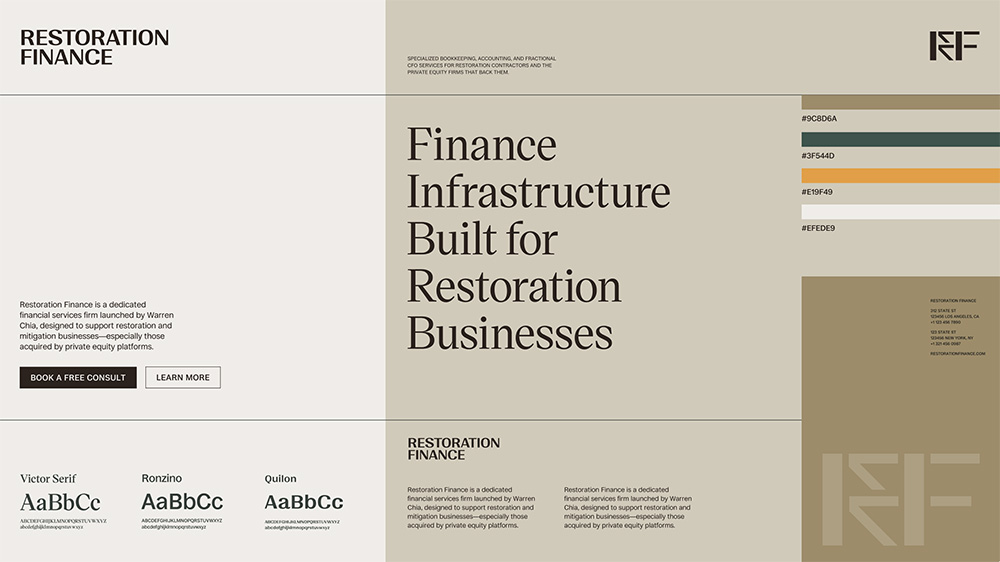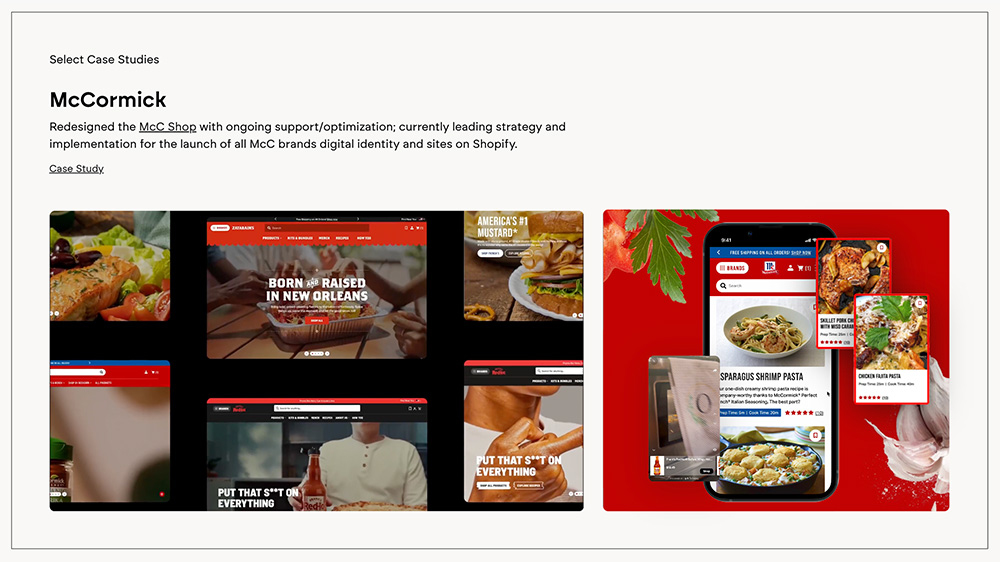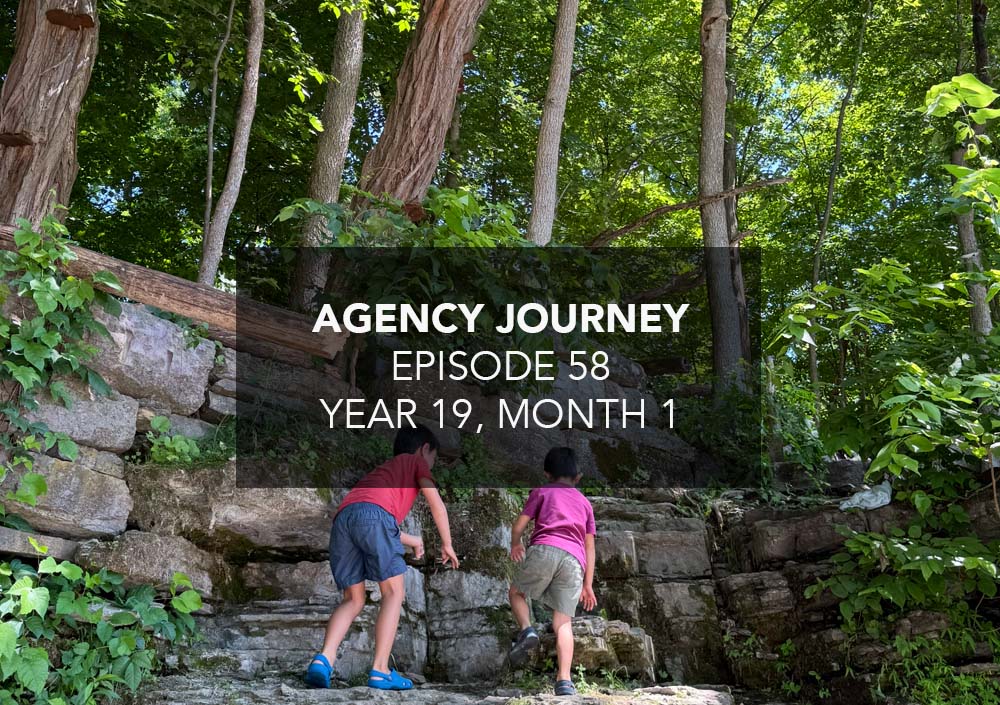We’re officially coming up on 1 year since I moved out of the CEO role at Barrel and handed over the reins to Lucas. Since then, Sei-Wook and I have been focused on building Barrel Holdings.
Under Lucas’s leadership, Barrel has had a strong past 12 months, posting high levels of profit and on track to post meaningful revenue growth for the first time in a few years. More than anything, I appreciate the way Lucas has held an uncompromising level of standard within Barrel. The quality of work and the retention of clients feels stronger than ever. There’s also a sense of momentum as Barrel continues to execute on his CPG commerce focus.
Coincidentally, I’m writing this on his birthday. It’s funny and amazing to look back 12 years ago, when a fresh-faced designer just a year out of school interviewed to join our team. He’s now a CEO, husband, father, and an accomplished leader. A very impressive guy.
When it comes to Barrel Holdings, Sei-Wook and I always come back to the fact that we get our greatest satisfaction from playing a part in supporting our agency leaders as they seize opportunities and realize their potential. It’s what we’ve found most energizing over the past year as we work with our portfolio companies and meet others we’d like to welcome into the fold.
About Agency Journey: This is a monthly series detailing the happenings at Barrel Holdings, a portfolio of agency businesses. You can find previous episodes here.
Highlights
Investing in AgencyHabits
In May, we brought on Ivona Namjesnik as our Marketing Lead at Barrel Holdings. Ivona previously worked in various roles at an ecommerce agency, leading marketing, creative teams, and overseeing other special projects. Her initial focus will be to build up AgencyHabits and help us realize our vision for having a robust media property that attracts and engages agency leaders.
I had been struggling to keep up with the weekly newsletter and was not making much momentum with our podcast plans. In a short time, Ivona’s taken both things off my plate while also initiating other activities like more social media posts on the AgencyHabits LinkedIn and improving our email automation flows.
The podcast should launch sometime in July and will feature weekly conversations between me and Sei-Wook about various agency and holding company topics. We’re also working to publish our Agency Systems Playbook sometime this summer. This is the framework that I’ve developed to help think through agency-related challenges.
Long-term, we’re looking to host virtual and in-person get-togethers so we can get to know our subscribers better. We’re also continually improving our flagship paid product, the The Business Development Collection, with new materials while keeping the price the same (customers will always have access to the latest content).
As I’ve mentioned in the past, AgencyHabits may not grow to be a big business, but we want it to become a valuable feeder of M&A opportunities and leadership talent for Barrel Holdings. I also think it can eventually become a small yet very profitable business on its own if we do it right.
Continually Improving Bolster’s Omakase
It’s been 2+ years since Bolster began offering their free brand design sprints known as the Omakase (see my original post The Agency Cold Start Problem). While things have cooled off from the initial two-a-week pace, the Bolster team continues to schedule one each week.
I sometimes send friends to Bolster to “get their brand done” for free. My close friend Warren, looking to start a finance and accounting firm for restoration companies, went through the process and got himself some free branding. He liked the work and thought the process was fairly tight but had feedback on how the “upsell” at the end felt a bit disjointed.

A slide from Bolster’s Omakase presentation to Restoration Finance.
From his perspective, having gotten something for “free”, he thought the jump to a $8,000 website offer felt too high. He also wished there were more a la carte options for certain templates (e.g. invoice template, PowerPoint deck template, etc.) that he could pick priced under $500 (much like the extra pieces of sushi you can offer after finishing your omakase course). I told him that Bolster had just landed some larger branding projects ($50k-$75k), so I could see how the Bolster team wouldn’t want to come down too much on price, but I also agreed that we could improve the Omakase experience.
What followed was a discussion with the Bolster team on the purpose of the Omakase and the importance of tailoring the experience to match a client’s expectations on process and budget.
The Omakase is a customer acquisition tool. It either lands us new paying clients or turns participants into willing referrers of new business. We realized that it was very clear from any introductory conversation that a prospective client was either a) interested in investing in a brand and web project or b) looking to get something done quick and inexpensively, if not for free.
For those with a budget set aside for brand and web project, we use the Omakase as a “try before you buy” audition and also assume that it is basically the first part of a full-on brand process (complete with brand strategy, logo workshop, multiple brand design directions, etc.). There is more workshopping and upfront intake, and we present our sample creative as just that – a small taste of what can come later.
Prospects participate in the Omakase with the full understanding that the complete project experience will cost tens of thousands of dollars, but if they don’t like how we work or what we present, they’re free to walk away and take whatever we create. One analogy that comes to mind is the sample meal you get when you tour wedding venues. We want to make a great impression with a freebie knowing that it can influence a very significant booking.
For those in the latter camp, looking to get something done on the cheap, the Omakase is our opportunity to win over a fan. In the short time we allot ourselves, we want to deliver something that’ll hit the mark and be instantly usable. We know from earlier conversations that the prospect has little to no budget right now, but would find a brand redesign incredibly helpful. They’re comfortable with getting something without giving much input, embracing the “omakase”/”trust me” concept. In successful situations, the client loves everything we present and is eager to run with it, asking for the Figma files and then instantly updating their company social account. In some situations, the client is grateful but ends up not using the branding or getting it tweaked elsewhere. And in rare situations, the participant is disappointed and never heard from again.
Those who end up using the Omakase designs or at least feel good about having done it are the ones who drive quite a bit of new business opportunities. They tell others about Bolster and how they liked what we did for them. We’ve had dozens of leads come this way and many of them ended up being businesses with budgets to spend for significant brand and web projects. The fact that their referrer got something for free via the Omakase never even came up in conversations.
We want to ensure that this stream of referrals from happy Omakase clients continues to happen, and that means creating an experience that leaves them feeling completely satisfied. What my friend Warren pointed out was a gap in the experience – the excitement of receiving a free new brand dampened by the realization that the implementation cost would be much higher than expected.
To that end, we’ve been rolling out more a la carte options including a one-page website solution for under $2k (perhaps closer to $1k eventually) as well as various sub-$1k designed collateral options. These are priced in a way not to drive a whole lot of profitable revenue, but to ensure that the investment we’re making in doing an Omakase has a chance to really drive impact for our future referrers.
Barrel’s Improved & Expanded Case Studies
Earlier in the year, Barrel lost a handful of close deals (we were the dreaded “top 2 finalist” that lost). When pressed for the reason we lost, the prospects told us that they thought the other agency had stronger creative chops.
I know this pained Lucas, who started his career as a designer and prides himself on having good taste. Initially, Lucas thought perhaps we needed to hire a creative director type talent to come in and infuse new energy into our work. However, upon closer review, Lucas felt that revamping our case studies and improving the presentation of our work could make a difference.

The deck format of the case study was upgraded with video embeds showing the breadth of the work.
Throughout the past few months, I’ve noticed a significant upgrade in Barrel’s case studies both in sales presentation decks and on the website. There’s greater use of motion and honing in on specific UX features/design choices vs. only showing a full screenshot of the website. This has also enabled better storytelling about the ecommerce features we added for the client and why they’re important in converting customers.

Instead of a straight screenshot, the Barrel team varied up the presentation of the work with more storytelling.
With these improved case studies, the Barrel website now features case studies collections for four categories: food & beverage, beauty & skincare, health & wellness, and home & family – hitting the major groups of CPG.
Best of all, this quarter, there hasn’t been any feedback about our creative chops being lacking.
Top of Mind
Revamping My Schedule: Less Meetings, More Focus Time
Almost a year into working full-time on Barrel Holdings, I thought it was a good time to revisit my weekly schedule and ask myself if I was spending time in the most effective way.
The answer was no.
I was spending too much time taking meetings, some necessary but many just random and not well-considered. These were 2, 3, 4, even 5 hours per day that I could have been focused doing other, more productive things.
And what would those productive things be?
Reading, for one. I have a very tall stack of books that I’ve barely made a dent into. These are mostly business books that I know may contain a handful of useful ideas or thought-starters that can help me greatly. Just the other day, I spent a few hours reading David Maister’s Strategy and the Fat Smoker and it sparked a bunch of ideas for AgencyHabits.
I’ve been conditioned to think that the workday is for meetings and conversations that it’s hard not to feel guilty when I use the time to read a book. But a couple hours spent with the right book can, in many cases, yield so much more insights than a meeting. And if I can shift even an hour of my workday to reading (5 hours/week), that’s an additional 2-3 books per month.
The other activity is writing. I devote 30-45 minutes to writing each day, mostly for my LinkedIn posts, but I have so much more writing I can be doing. Whether it’s working on the Agency Systems Playbook, my guide to holding companies, writing a memo to our agency leaders, or working on a speaking presentation, I have an ever-growing list of writing projects that simply don’t get enough time. If I can shift 2-3 hours per day towards writing, I know good things can happen.
The last activity I’ll bucket as “creative stuff”. This can range from the weekly podcast recordings I do with Sei-Wook (which requires some prep) to creating some video content for AgencyHabits and social to engaging in deeper vibe-coding sessions. Giving myself time to make things, get out of my comfort zone, and explore. Instead of confining these activities to my lunchtime or late evenings, I can give up a couple of Zoom call slots.
It’ll take another month or so to wean myself off of more back-to-back Zoom call days, but I’ve experienced a few days of minimal calls (1-2) and they’ve been incredibly productive. We’ve created some processes that allows us to delegate initial M&A calls and being stricter with our qualification criteria means taking less calls.
I’ll still make room to take calls with new people, to catch up with people in my network, and do my check-ins with our agency leaders. But the days of letting calls take up 80-90% of my days are over. There’s much to do learn and do, and it’s time my schedule reflected my priorities.
Shared Quotes
“Mastery of creative tension transforms the way one views ‘failure.’ Failure is, simply, a shortfall, evidence of the gap between vision and current reality. Failure is an opportunity for learning—about inaccurate pictures of current reality, about strategies that didn’t work as expected, about the clarity of the vision. Failures are not about our unworthiness or powerlessness.” (Peter M. Senge, The Fifth Discipline)
Decoupling failure from personal worth is a huge unlock. It takes the ego out of your endeavors and makes it more about continuous growth and learning. It’s also a great mindset for gearing up daily–I know that I’m bound to “fail” in one shape or another, but what excites me is the prospect of learning, getting better, and ultimately closing the gap ever so slightly between where I am and where I want to go.
“As soon as we experience the slightest dip in motivation, we begin seeking a new strategy—even if the old one was still working. As Machiavelli noted, “Men desire novelty to such an extent that those who are doing well wish for a change as much as those who are doing badly.”” (James Clear, Atomic Habits)
I’ve been guilty of this throughout my career, and it’s the reason I want Barrel Holdings to be my redemption arc. The ability to hold firm on a strategy and see it through is very underrated. I think we have a good strategy in place for Barrel Holdings – acquiring, launching, and managing cash-flowing specialized agencies and compounding over many years. It’s a matter of being patient, disciplined, and seeing it through.
“Tenure of relationships is also a key item to consider. Boutiques that generate billings from clients for years are attractive. This suggests that the client relationships are strong. If the boutique did not deliver value, clients would go elsewhere. A rule of thumb is that the average client tenure should be three years or more.” (Greg Alexander, The Boutique)
Client retention is the foundation of sustainable growth for an agency business. You might have a well-oiled sales machine that closes new logos each month, but it’s the ability to keep clients for longer than the initial engagement that helps to build revenue and profits in the long run.
